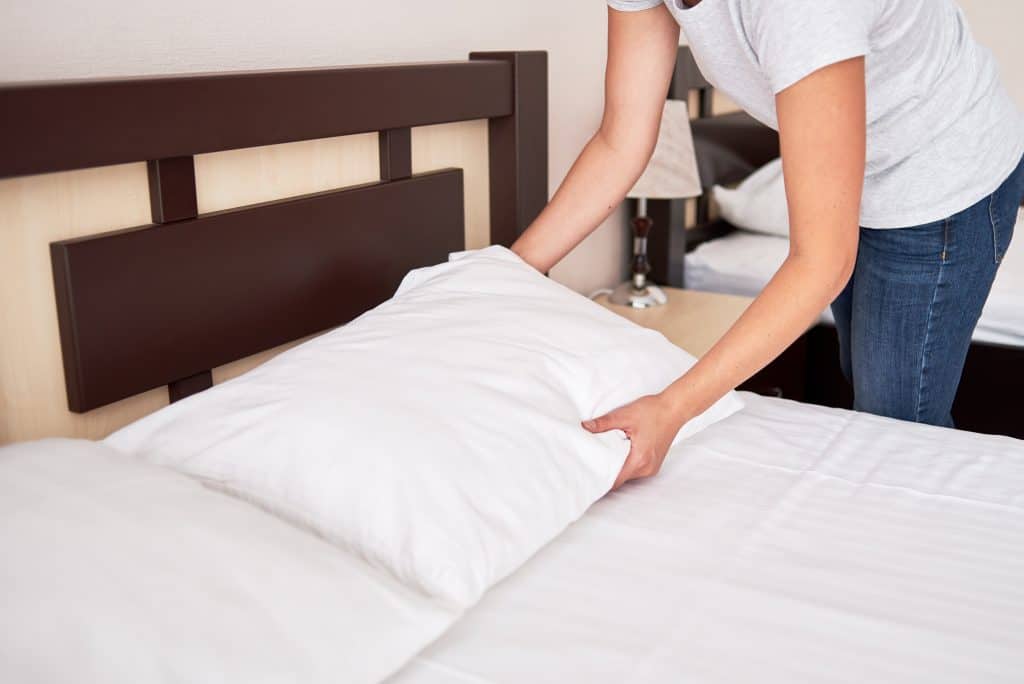Pillow Advice
How Often Should You Change Your Pillows?
When was the last time you replaced them? How often do you change your pillowcases? How about your pillows, how often do you wash them?
The truth is, we don’t often think about our pillows. Many people will change bedding every week but don’t really think about when it’s time to wash their pillows, until they’re no longer comfortable or start to stink. But did you know that your pillows (and other bedding) need to be replaced after a certain amount of time?
Reasons to Replace Pillows

The right kind of pillow can help improve sleep quality. However, they don’t last forever. Materials and fillings break up over time. Aside from this, pillows are excellent depositories for sweat, dirt, dust, germs, saliva and even fungus. Yes, we change pillowcases more frequently than pillows but these gross substances can actually seep into the fibres or material of the pillow. This is why they need replacing.
As more saliva, hair, dirt and germs get deposited into your pillow, dust mites will become more attracted to it. Dust mites multiply quickly, and even if you don’t notice them, they actually add weight to your pillows. Dust mites are not really dangerous because all they do is feed on your dead skin cells, but thinking about them can be unsettling. People with allergies have a bigger problem though because they can actually worsen their symptoms, which could then interfere with sleep.
Aside from this, the covering and filling break down after years of use. For example, fibrefill pillows get clumpy over time. Even if they are fluffed every day, the fibres will eventually bind together and form clumps, which can prevent you from having a good night’s rest.
Memory foam can also break down after repeated use. Over time, you might find that it no longer provides the same support as before, so sleep quality can get poorer as the years roll by. Dust mite presence can also contribute to the material breakdown of your pillows.
Even if you change pillowcases and wash pillows frequently, it can’t permanently solve the dust mite problem. Frequent washing can speed up material breakdown.
When to Replace Pillows?
There are many pillow varieties available in the market, and some of them need changing more than others. Here is the general lifespan of the most common types of pillows in the market.
- Latex – 5 to 6 years
- Buckwheat – 5 to 6 years
- Down or feather – 4 to 5 years
- Memory foam – 3 to 4 years
- Polyester or fibrefill – 18 to 24 months
- Synthetic down – 18 to 24 months
- Bamboo – 18 to 24 months
Signs to Replace Your Pillows
As a rule of thumb, it is better to replace pillows every 2 years. Some pillows have longer longevity. For instance, down pillows are usually more durable and can provide good support even after 5 years, especially if they are maintained regularly. Latex and memory foam last longer than down pillows but their maintenance is more complicated than normal fibrefill pillows.
Whatever type of pillow you use, it’s good to note these signs to replace your pillows.

- Waking up with a headache, neck pain or shoulder pain is always a bad sign. This means that you’ve been sleeping with your neck and muscles misaligned. Your pillow’s job is to keep them in proper alignment, so waking up in pain could mean that your pillow has lost its ability to provide proper support to these areas.
- Clumpy pillows are always uncomfortable. They stress various areas in the head and neck, which can lead to aches and pains. Replace clumpy pillows immediately.
- Stains and odour are always bad signs. If you can’t get them out by washing your pillows, replace them with new ones.
- Dust mites are not a problem for many people. However, allergy sufferers experience a worsening in symptoms when they sleep in dust-mite-infested pillows. If you have allergies and wake up sneezing, it’s time to buy new pillows.
- Fluffy pillows are comfortable because they provide support when needed. However, they lose support over time. This can be due to the degradation of the material used. Headaches and body pains are usually signs that your pillow has lost its supportiveness.
- Try folding your pillow in half. If it stays that way when you let go, then you need to change it. Pillows have to expand by themselves after being folded in half.
- A change in sleeping position means a change in pillows. For example, you’ve shifted from side sleeping to stomach sleeping. Pillows for side sleepers are generally firmer compared to pillows for stomach sleepers. If you’re sleeping more on your stomach, you need to change to a thinner and softer pillow to prevent neck and shoulder pain.
Pillow Maintenance
In order to make sure that your pillow makes it to its maximum lifespan, you need to maintain them regularly.
Here are tips for pillow maintenance.
- Pillow covers – Pillow covers are different from pillowcases. The former is a cover that has zippers on one side and is used as an extra barrier for your pillow. After you put on a pillow cover, you can then use a pillowcase.
Pillow covers can prevent sweat, saliva and odours from penetrating into your pillow. They should be washed every 3-4 weeks. After you put on a pillow cover, put on your pillowcase. This one should be changed every week along with your bed sheets.
- Washing your pillow every 6 months can also help extend its durability. Always check the label to see if it is machine-washable. Different pillow fillings require different types of care, so make sure to follow directions.
Latex and memory foam pillows are not machine-washable, but they should still be washed and cleaned regularly. You can use baking soda to clean latex and memory pillows. A good alternative is to dip a clean rag in soapy water and gently use it to wipe away stains.
Wrap-up
The most important thing to consider is your health. Poor sleeping posture can lead to headaches. Replacing pillows regularly is a cheap way of ensuring that you get a proper rest every night.

